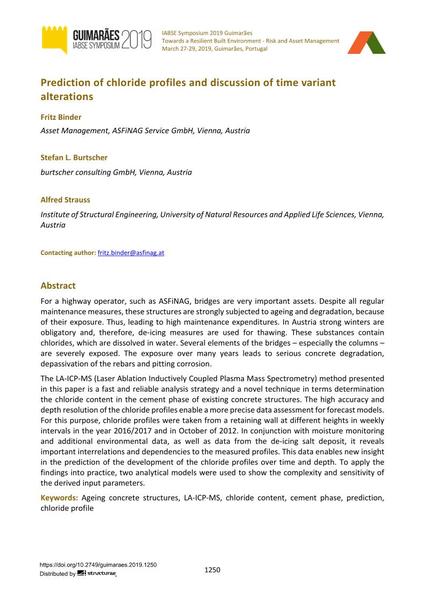Prediction of chloride profiles and discussion of time variant alterations

|
|
|||||||||||
Détails bibliographiques
| Auteur(s): |
Fritz Binder
(Asset Management, ASFiNAG Service GmbH, Vienna, Austria)
Stefan L. Burtscher (burtscher consulting GmbH, Vienna, Austria) Alfred Strauss |
||||
|---|---|---|---|---|---|
| Médium: | papier de conférence | ||||
| Langue(s): | anglais | ||||
| Conférence: | IABSE Symposium: Towards a Resilient Built Environment Risk and Asset Management, Guimarães, Portugal, 27-29 March 2019 | ||||
| Publié dans: | IABSE Symposium Guimarães 2019 | ||||
|
|||||
| Page(s): | 1250-1260 | ||||
| Nombre total de pages (du PDF): | 11 | ||||
| DOI: | 10.2749/guimaraes.2019.1250 | ||||
| Abstrait: |
For a highway operator, such as ASFiNAG, bridges are very important assets. Despite all regular maintenance measures, these structures are strongly subjected to ageing and degradation, because of their exposure. Thus, leading to high maintenance expenditures. In Austria strong winters are obligatory and, therefore, de-icing measures are used for thawing. These substances contain chlorides, which are dissolved in water. Several elements of the bridges – especially the columns – are severely exposed. The exposure over many years leads to serious concrete degradation, depassivation of the rebars and pitting corrosion. The LA-ICP-MS (Laser Ablation Inductively Coupled Plasma Mass Spectrometry) method presented in this paper is a fast and reliable analysis strategy and a novel technique in terms determination the chloride content in the cement phase of existing concrete structures. The high accuracy and depth resolution of the chloride profiles enable a more precise data assessment for forecast models. For this purpose, chloride profiles were taken from a retaining wall at different heights in weekly intervals in the year 2016/2017 and in October of 2012. In conjunction with moisture monitoring and additional environmental data, as well as data from the de-icing salt deposit, it reveals important interrelations and dependencies to the measured profiles. This data enables new insight in the prediction of the development of the chloride profiles over time and depth. To apply the findings into practice, two analytical models were used to show the complexity and sensitivity of the derived input parameters. |
||||
